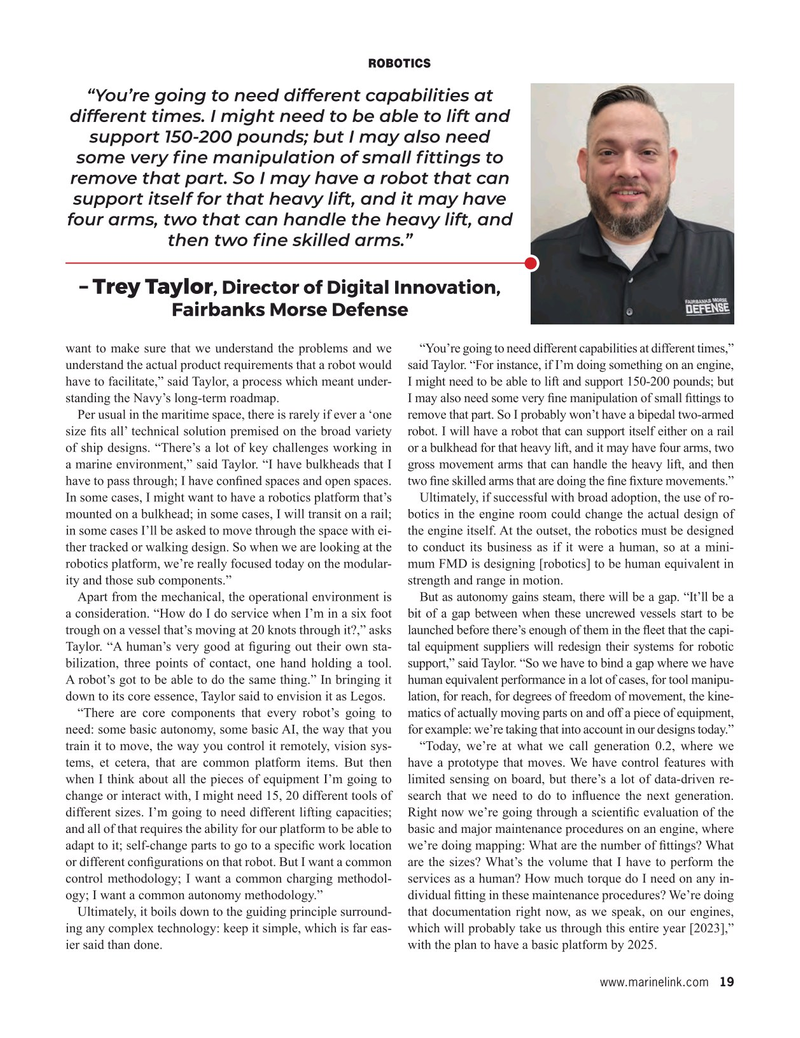
Page 19: of Maritime Reporter Magazine (December 2023)
Great Ships of 2023
Read this page in Pdf, Flash or Html5 edition of December 2023 Maritime Reporter Magazine
ROBOTICS “You’re going to need different capabilities at different times. I might need to be able to lift and support 150-200 pounds; but I may also need some very ? ne manipulation of small ? ttings to remove that part. So I may have a robot that can support itself for that heavy lift, and it may have four arms, two that can handle the heavy lift, and then two ? ne skilled arms.” – Trey Taylor, Director of Digital Innovation,
Fairbanks Morse Defense want to make sure that we understand the problems and we “You’re going to need different capabilities at different times,” understand the actual product requirements that a robot would said Taylor. “For instance, if I’m doing something on an engine, have to facilitate,” said Taylor, a process which meant under- I might need to be able to lift and support 150-200 pounds; but standing the Navy’s long-term roadmap. I may also need some very ? ne manipulation of small ? ttings to
Per usual in the maritime space, there is rarely if ever a ‘one remove that part. So I probably won’t have a bipedal two-armed size ? ts all’ technical solution premised on the broad variety robot. I will have a robot that can support itself either on a rail of ship designs. “There’s a lot of key challenges working in or a bulkhead for that heavy lift, and it may have four arms, two a marine environment,” said Taylor. “I have bulkheads that I gross movement arms that can handle the heavy lift, and then have to pass through; I have con? ned spaces and open spaces. two ? ne skilled arms that are doing the ? ne ? xture movements.”
In some cases, I might want to have a robotics platform that’s Ultimately, if successful with broad adoption, the use of ro- mounted on a bulkhead; in some cases, I will transit on a rail; botics in the engine room could change the actual design of in some cases I’ll be asked to move through the space with ei- the engine itself. At the outset, the robotics must be designed ther tracked or walking design. So when we are looking at the to conduct its business as if it were a human, so at a mini- robotics platform, we’re really focused today on the modular- mum FMD is designing [robotics] to be human equivalent in ity and those sub components.” strength and range in motion.
Apart from the mechanical, the operational environment is But as autonomy gains steam, there will be a gap. “It’ll be a a consideration. “How do I do service when I’m in a six foot bit of a gap between when these uncrewed vessels start to be trough on a vessel that’s moving at 20 knots through it?,” asks launched before there’s enough of them in the ? eet that the capi-
Taylor. “A human’s very good at ? guring out their own sta- tal equipment suppliers will redesign their systems for robotic bilization, three points of contact, one hand holding a tool. support,” said Taylor. “So we have to bind a gap where we have
A robot’s got to be able to do the same thing.” In bringing it human equivalent performance in a lot of cases, for tool manipu- down to its core essence, Taylor said to envision it as Legos. lation, for reach, for degrees of freedom of movement, the kine- “There are core components that every robot’s going to matics of actually moving parts on and off a piece of equipment, need: some basic autonomy, some basic AI, the way that you for example: we’re taking that into account in our designs today.” train it to move, the way you control it remotely, vision sys- “Today, we’re at what we call generation 0.2, where we tems, et cetera, that are common platform items. But then have a prototype that moves. We have control features with when I think about all the pieces of equipment I’m going to limited sensing on board, but there’s a lot of data-driven re- change or interact with, I might need 15, 20 different tools of search that we need to do to in? uence the next generation. different sizes. I’m going to need different lifting capacities; Right now we’re going through a scienti? c evaluation of the and all of that requires the ability for our platform to be able to basic and major maintenance procedures on an engine, where adapt to it; self-change parts to go to a speci? c work location we’re doing mapping: What are the number of ? ttings? What or different con? gurations on that robot. But I want a common are the sizes? What’s the volume that I have to perform the control methodology; I want a common charging methodol- services as a human? How much torque do I need on any in- ogy; I want a common autonomy methodology.” dividual ? tting in these maintenance procedures? We’re doing
Ultimately, it boils down to the guiding principle surround- that documentation right now, as we speak, on our engines, ing any complex technology: keep it simple, which is far eas- which will probably take us through this entire year [2023],” ier said than done. with the plan to have a basic platform by 2025.
www.marinelink.com 19
MR #12 (18-33).indd 19 12/5/2023 12:25:04 PM

 18
18

 20
20
